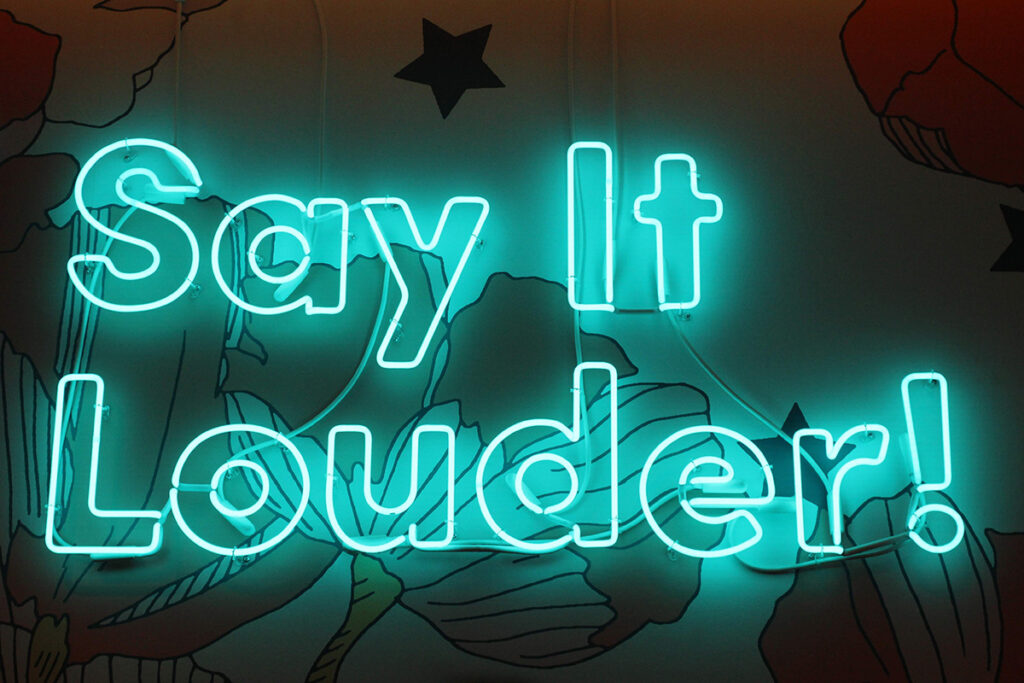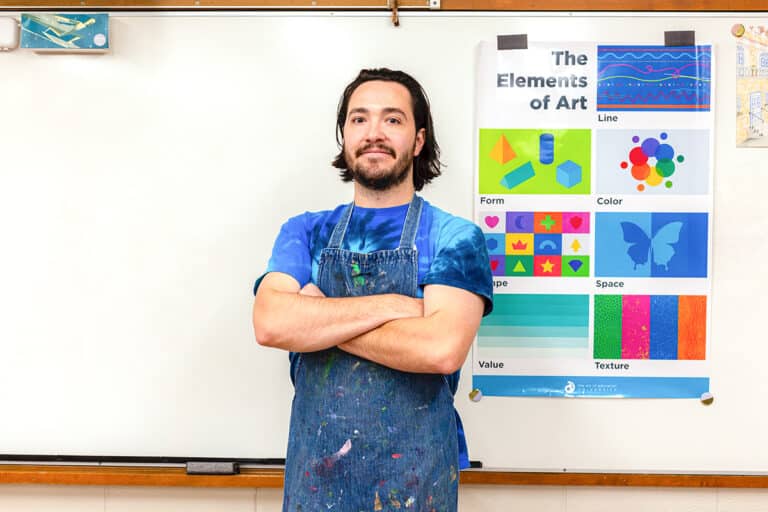We continue to navigate the profound impact of an awakening brought upon by extreme politics, racial injustices, and collective trauma during and post-pandemic. We also continue to reflect and consider where we were and where we are going as a country, educational system, and as educators. While sitting in this tumultuous season, we must also take time to reflect upon our belief systems, how we interpret research, our personal and professional biases, and what we value as art educators.
One thing we can all agree upon, however, is that the arts are essential!
As art educators, what and how we teach will always be a passionate discussion. The truth is, there is no one way to teach our students. If we continue to be reflective and responsive in our teaching practice, then the heart of why we teach art will always be clear. No matter what is going on in our lives, communities, and country, we know the significant impact a quality arts education has on the next generation. No one needs to tell us all the reasons why arts education is a must—it is ingrained in our souls. How do we remind the world that what we feel is more than a “feeling” but is an essential skill set?
While some programs have found an increase in arts enrollment during the pandemic, many students (and school administrators) have doubled down on core classes. Some students crave our art classes, already aware of the benefits. But many parents and students fear falling behind in the present and the long-term impact when students apply for college. How do we continue to advocate for the visual arts and navigate the challenges, obstacles, and ever-changing priorities set by our schools, the community, and beyond?
Here are 6 big picture problems facing education right now and how the arts already combat these issues.
1. The Problem: Learning Loss
Whether perceived or real, we have some catch-up to do. Even in the art room, we see areas in need of extra support. Our littlest artists may not have stepped foot into a classroom setting until this school year. Some of our most advanced students may not have had any in-person studio classes. Students at every level need extra support. If we see it in the art room, it’s clear this issue spans all content areas. Unfortunately, the “learning gap” focuses heavily on core classes such as math and English as they are tested subjects. Districts may cut your class time in half or altogether do away with art in favor of extra core resources. Students may be more likely to choose study halls instead of elective classes.
What we can do:
- Emphasize the gains: empathy, creativity, resourcefulness, flexibility, and did I mention…creativity?
- Share how outside-the-box thinking is a commodity in various careers.
- Identify and develop students’ strengths outside of core subjects.
- Build stamina by having a balanced day.
- Advocate for cross-curricular connections developed through art.
Looking for more backup? Check out these articles:
- Creativity and Academics: The Power of an Arts Education
- Research Reports from Americans for the Arts
- How the Arts Benefit Your Children Academically and Behaviorally
- New Evidence of the Benefits of Arts Education
- Why Arts Education Is Crucial, and Who’s Doing It Best
- Arts Facts: SAT Scores and the Arts 1999 – 2015
- Benefits of Art Activities
2. The Problem: Initiatives Take Precedence
New initiatives impact how the arts integrate and support school-wide plans. Often, these initiatives involve more work added to our already overflowing plate. Many districts are adopting, a focus on social-emotional learning. It is the perfect time to become a leader at your school! Be a team player—advocate for the arts by sharing the intrinsic benefits of visual arts in connection with SEL.
What we can do:
- Identify how the arts standards align with SEL standards.
- Share how your class provides space to dig deeper into SEL competencies.
- Propose a professional development session demonstrating arts integration into other curricula.
- Remind counselors and scheduling teams how taking an art class supports mental well-being.
- Set boundaries to remind administration that you are not an art therapist and art class is not therapy, albeit therapeutic.
Looking for more articles to support your case?
- Casting the Conceptual Net: Cognitive Possibilities for Embracing the Social and Emotional Richness of Art Education
- How Sport and Art could be Effective in the Fields of Social, Cognitive and Emotional Learning?
- Local-Level Implementation of Social-Emotional Learning in Arts Education: Moving the Heart through the Arts
- Arts Education and Social-Emotional Learning Outcomes among K-12 Students: Developing a Theory of Action
- Social and Emotional Learning Through Creative Classrooms
- Social and Emotional Learning and Arts Education
- Art and Social-Emotional Learning
3. The Problem: Lack of Socialization
Students, especially our younger elementary students, have forgotten or never properly learned what it was like to engage with each other pre-pandemic. What does collaboration look like now that we are distanced, masked, and with individual sets of supplies? Even at the secondary level, students can still struggle to speak up when asked a question and do not always willingly collaborate with peers when given the opportunity. While engagement may have been a struggle pre-pandemic, these social skills need to be reintroduced and practiced.
What we can do:
- Inject collaborative group work and make it visible to your school and community.
- Engage students in ways to share tools and materials instead of personal sets.
- Challenge creative thinking in pairs and small groups through quick exercises and fun, hands-on experiences.
- Sprinkle critiques throughout the artmaking process to foster peer discussion.
Include these advocacy articles in your next proposal or learn ways to create change in your school and community:
- Working Together: Teaching Collaboration in the Arts
- A Look at How Arts Teachers Can Promote a Sense of Community
- Collaboration in the Classroom and Beyond
- Why Is Arts Education Important for 21st-Century Learning? 5 Reasons to go from STEM to STEAM
- 6 Crucial Collaboration Skills (and How to Foster Them)
4. The Problem: Technology Overload
As you heard in the Art Ed Radio episode, Leaving Tech Behind, most students need a technology detox. Pre-pandemic, technology was infused in all content areas and increasingly leaned upon in various teaching strategies. After remote and hybrid learning, we have seen the impact of hours of screens on our students. Intense amounts of screen time impact our brains from increased stress to decreased sleep and overall mental health. We are uniquely poised to change that dynamic in the art room. Help students disconnect and engage with their environment, exercise their fine motor skills, and create outside the screen.
What we can do:
- Implement technology as a tool to get to the good stuff instead of being the only modality.
- Integrate physical media into digital media. For example, digitally edit an image, then print it out to cut, paste, and collage. Or, design a package in Illustrator, then print it, and construct it.
- Prompt handwriting, reading books (yes, books!), and presenting physical artifacts beyond the computer screen.
Looking for more ways to reduce tech and get back to hands-on activities?
- Working with Your Hands Is Good for Your Brain
- Working With Your Hands Does Wonders for Your Brain
- 4 Health Benefits of Working with Your Hands
- Can a Digital Detox Improve Student Mental Health?
- Digital Detox through Art Therapy
- Experiencing a Digital Detox (Ep. 123)
5. The Problem: Lack of Funding
Let’s call a spade a spade. Funding for the arts is—and always has been—an issue. As learning loss shifts its focus to core content areas such as math and reading, funding will flow away from the arts. Parents don’t want to pay for extra math tutoring when the school can make that adjustment during the school day. You may feel like this is an uphill battle and one you are too exhausted to fight right now. Unfortunately, for many art teachers, your job may be on the line when funding shifts to other areas.
What we can do:
- Make art highly visible in your school and community.
- Communicate the skills students are developing beyond the technical with parents and administrators.
- Use video to connect student voice with their artwork.
- Write a grant proposal for special projects that impact the school as a community.
- Connect art with 21st-century skills.
- Collaborate with core content teachers to integrate art into other areas.
Here is some more support to help you ask for more funds:
- Importance of Arts Education
- Why Public Funding for the Arts Matters
- Webinar: How to Leverage CARES Funds for Your Visual Arts Department
- What Art Teachers Need to Know About the CARES Act
- What Art Educators Need to Know About the American Rescue Plan
- Arts ARE Education: Resolving to Support Arts Education Funding and Programs in the Post-Pandemic Era
- How to Find Arts Integration & STEAM Funding
6. The Problem: Collective Trauma
Collective trauma reaches across age, skin color, gender, or sexuality. We all have experienced trauma to varying levels over these past few years. This trauma includes (but is not limited to) constant fear, overwhelming loss, ongoing uncertainty, pervasive racism, and political and environmental unrest. Students and teachers walk a thin line as we move from class to class throughout our day. The art room is no stranger to holding the emotional trauma we all carry. How can we share the very special gift that art has in helping to process and heal?
What we can do:
- Provide opportunities to process traumatic experiences through open-ended prompts as students explore what is comfortable for them.
- Work with your student services team to provide resources for students expressing severe trauma.
- Work collaboratively to create a public installation in response to the collective trauma.
- Provide a safe space for the nonverbal processing of grief and trauma that doesn’t need to be shared publicly. The community will quickly learn about the importance of your environment without you having to shout it out.
Add these articles to your cache of resources:
- Art Teachers are a ‘Secret Weapon’ for Restoring Students’ Mental Health, Expert Says
- Improving Social Skills through Collaborative Artwork and Group Activity
- Art Therapy Can Speed Up Your Healing: And We Are Here to Help!
- Art Therapy for Art Teachers
- Art Therapy for Art Teachers (Ep. 195)
- Expressive Arts as Means to Heal Trauma
- New Program Helps Youth of Color Process Racial Trauma through Art
- Creative Healing Spaces: Healing From Racial Wounds
- Addressing Racial Injustice through Art
- Art Education in the Face of Injustice
As passionate art educators, we already know all the reasons why the arts are essential. You don’t need to add more to your plate to advocate for your program.
If you are looking to make a big splash, creating large-scale installations can shift the school environment. Writing advocacy letters to administration and government officials can be copied, pasted, and tweaked to make a large impact beyond your immediate community. Pursue grants to respond to current events through artmaking. Work with outside organizations and working artists to connect the real world back into the classroom bubble. AOEU’s complimentary workshop, The Art of Writing: Why Writing Matters in Art Education, is a great tool for improving your writing beyond the classroom.
But don’t forget—the work you do in your classroom is already combatting what our students manage daily. Slipping reminders to your administration and community doesn’t have to take a lot of energy or time. Link the resources here to newsletters, social media posts, or your signature in your emails. Even small reminders go a long way to constantly connect the very large and very real impact the arts have on our students, both short and long term.
Looking for more research to support your case?
- Why We Need Arts in Times of Crisis
- Why We Need the Arts and Humanities to Get us through the COVID-19 Pandemic
- The Essential Role of Art has Been Exhibited During the COVID-19 Shutdowns
- The Role of Art in Times of Pandemic
- How Art Can Help You Cope With the Pandemic
- Stressed Out? Art can Help Us Get through the Coronavirus Pandemic
- In a Time of Crisis, Is Art Essential?
- Forum Report: The Role of the Arts Post-Pandemic
- The Transformative Role of Art During the Pandemic
- As the Coronavirus Upends Schools, Experts Say Don’t Forget the Arts
What are your favorite arts advocacy tools?
What other issues can you think of that the arts help combat?
Magazine articles and podcasts are opinions of professional education contributors and do not necessarily represent the position of the Art of Education University (AOEU) or its academic offerings. Contributors use terms in the way they are most often talked about in the scope of their educational experiences.











